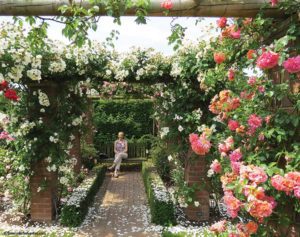July 9 Column: David Austin Roses Display Gardens (Travel)

Oh my. I’ve recently had one of those life-altering garden experiences. I am delighted to share it with you in my column today. It’s about my recent visit to the David Austin Roses display gardens, located in Albrighton, England. Here is a link to my column in today’s edition of The Spokesman-Review. Home visit with breathtaking views of Austin roses. (or you can read my column lower in this post)
In it, I explain how David Austin has been breeding stunningly beautiful roses since the 1950s. Today at age 91, he and his family are still very much involved with the business of sharing these gorgeous roses.
In today’s “Everyone Can Grow A Garden!” video, I take you on a virtual tour of the display gardens. I also share photos of some of the rose cultivars I loved the most. It should be a visual treat for you!
Here are more details about the gardens:
Location: Bowling Green Lane, Albrighton (village), Wolverhampton (city) WV7 3HB (you can use this post code in a GPS to find the gardens)
Email: plantcentre@davidaustinroses.co.uk
Hours: gardens, plant center and gift shop 9 a.m. to 5 p.m. daily, tea room 9:30 a.m. to 4:30 p.m. daily
Admission is free!
David Austin Roses garden column:
by Susan Mulvihill
When I think of an English garden, a vision of rose blossoms immediately comes to mind. And not just any roses, mind you, but English roses in particular.
David Austin has been breeding them since the 1950s, by combining the heady scents of old roses with the superior performance of more modern ones. His roses are well-known for their breathtaking beauty and fragrance, and have long been a favorite of mine.
While in the early planning stages for a June trip to England, I spotted a magazine ad for the David Austin Roses display gardens. They are located in the village of Albrighton, about an hour’s drive from Stratford-upon-Avon. Since the latter would be our home base for a few days, I immediately added the gardens to my sightseeing wish list.
Covering about 2 acres, the gardens are divided into separate “rooms” surrounded by brick walls or clipped hedges. In addition to borders planted with roses, we saw arbors covered with roses, a beautiful reflecting pool and charming sitting areas where visitors can take in the enchanting views. Attractive sculptures created by the talented artist Pat Austin (David Austin’s late wife) provide focal points.
In addition to the gardens, visitors can stroll through the plant center and gift shop, or dine in the cafe and tea room. While I couldn’t bring plants home, I treated myself to couple of mementos and a delicious lunch.
After exploring every square inch of the gardens at least twice, I visited with plant center advisor Di Perry to learn more about them. In 1969, they began as a nursery with stock beds the public could view.
“We started with a tiny little shed and our plant list was printed on a single sheet of paper,” she recalled. “We’ve greatly expanded it over the years and thousands of people visit annually.”
Today, one only has to look at their 121-page, full-color catalog to learn how popular David Austin roses have become.
Technical Director and Senior Rosarian Michael Marriott shared the best times to visit the gardens.
“The main season of flowers is usually June going into July, with another good show in September, but it goes on into October and even November,” he told me.
In the United States, there are David Austin test gardens located in New York, California and Texas. This allows them to trial the roses in different climate zones and conditions. The garden in Farmers Branch, Texas, is the only one open to the public. Many public gardens also provide opportunities to admire these magnificent roses, however.
“There are many Austin roses in the New York Botanical Garden, the Portland (Ore.) Rose Garden and the American Rose Society’s garden in Shreveport, Louisiana,” Marriott said.
He also explained how the budwood for Austin roses sold in the U.S. initially comes from England and then goes through a two-year quarantine period. The roses we buy in our local nurseries are propagated and grown in either California or Arizona.
That explains why some of the newest roses I saw in England won’t be available for a while. I was particularly drawn to Sweet Juliet, Dame Judi Dench and James L. Austin. Someday I hope to add them to my garden.
Of all the places we visited during our trip, I would rank the David Austin gardens right at the top. To learn more about them, go to davidaustinroses.com/us/plant-center-and-gardens.

